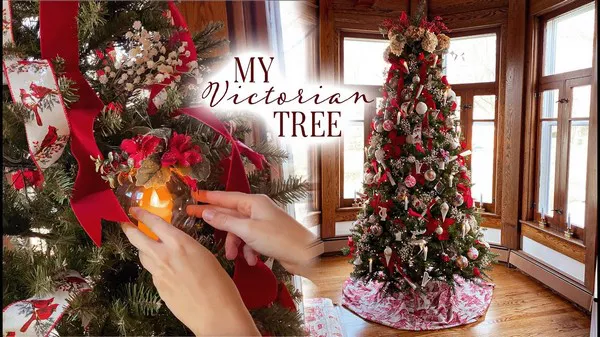The tradition of the Christmas tree, now ubiquitous in many cultures around the world, finds its roots deeply embedded in history, particularly in the Victorian era. As we delve into the historical background, delve into the main characteristics, unravel the symbolism and tradition, and explore additional references, we uncover the essence of the Victorian Christmas tree—a symbol of elegance, tradition, and the festive spirit.
Historical Background
The Victorian era, spanning from 1837 to 1901, marked a period of profound cultural, societal, and industrial transformation in Britain. Named after Queen Victoria, this era witnessed significant changes in various aspects of life, including art, literature, fashion, and customs. One of the most enduring legacies of the Victorian era is the transformation of Christmas into a widely celebrated and cherished holiday.
Prior to the Victorian era, the celebration of Christmas in Britain was relatively modest compared to contemporary festivities. However, with the advent of industrialization and the resurgence of romanticism, Christmas underwent a remarkable revival, evolving into the elaborate and joyous occasion that we recognize today.
Main Characteristics of the Victorian Christmas Tree
Central to the Victorian celebration of Christmas was the adorned Christmas tree—a tradition that gained popularity during the early years of Queen Victoria’s reign. The Victorian Christmas tree was characterized by several distinctive features:
1. Ornate Decorations: Victorian Christmas trees were lavishly decorated with an array of ornaments, including glass baubles, tinsel, candles, and handcrafted decorations. These ornaments, often meticulously crafted and adorned with intricate designs, added a touch of opulence to the tree.
2. Candles: Perhaps one of the most iconic features of the Victorian Christmas tree was the use of real candles to illuminate the branches. These candles, symbolizing the warmth and light of the season, were carefully affixed to the tree and lit during festive gatherings. While undeniably beautiful, the use of candles posed significant fire hazards, leading to the eventual transition to safer electric lights.
3. Natural Elements: Victorian Christmas trees were often adorned with natural elements such as fruits, nuts, and berries, symbolizing abundance and fertility. These additions not only enhanced the visual appeal of the tree but also reflected the agricultural roots of the holiday season.
4. Handmade Ornaments: Handcrafted ornaments played a significant role in Victorian Christmas decorations. Families would spend hours creating delicate paper decorations, fabric ornaments, and intricate garlands to adorn their trees, adding a personalized touch to the festivities.
5. Topper: The Victorian Christmas tree was typically crowned with a decorative topper, often in the form of an angel, star, or elaborate finial. This crowning ornament served as a focal point, symbolizing hope, guidance, and the spirit of Christmas.
Symbolism and Tradition
The Victorian Christmas tree was not merely a decorative centerpiece but also a symbol rich in meaning and tradition:
1. Unity and Family: The gathering of family and friends around the Christmas tree symbolized unity, love, and togetherness—a cherished sentiment during the Victorian era, particularly amidst the societal changes brought about by industrialization.
2. Renewal and Rebirth: The evergreen nature of the Christmas tree symbolized resilience, renewal, and the promise of spring amidst the darkness of winter—a metaphorical reminder of hope and optimism during challenging times.
3. Spiritual Significance: For many Victorians, the Christmas tree held religious significance, representing the Christian belief in the birth of Jesus Christ. The tree’s lights were seen as symbols of Christ as the light of the world, illuminating the darkness of sin and bringing salvation to humanity.
4. Social Status: In Victorian society, the elaborate decoration of the Christmas tree also served as a display of social status and refinement. Wealthier families would spare no expense in adorning their trees with luxurious ornaments, while more modest households would opt for simpler decorations.
5. Continuity of Tradition: The Victorian Christmas tree symbolized the continuity of tradition and the passing down of customs from one generation to the next. As families gathered around the tree year after year, the rituals and memories associated with it became deeply ingrained in the fabric of Victorian culture.
Additional References
The influence of the Victorian Christmas tree extended far beyond Britain, spreading to other parts of the world through cultural exchange and immigration. In the United States, for example, the tradition of the Christmas tree was popularized during the 19th century by German immigrants, who brought with them the customs of their homeland, including the decorated Christmas tree.
Contemporary depictions of the Victorian Christmas tree can be found in literature, art, and popular culture, serving as enduring symbols of nostalgia and holiday cheer. Works such as Charles Dickens’ “A Christmas Carol” and Thomas Nast’s illustrations in Harper’s Weekly helped popularize the image of the adorned Christmas tree, further cementing its place in the collective imagination.
Conclusion
In conclusion, the Victorian Christmas tree stands as a testament to the enduring power of tradition, symbolism, and communal celebration. Through its ornate decorations, rich symbolism, and timeless appeal, it continues to captivate hearts and minds, inviting us to embrace the spirit of the season and cherish the bonds of family, love, and togetherness.






















